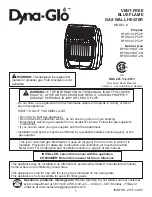
O
Op
pe
erra
attiin
ng
g IIn
ns
sttrru
uc
cttiio
on
ns
s CORREX
®
UP 2.3-919
39
3. Besides the CORREX
®
UP system, another magnesium anode is still in place.
Inspection: Check whether one or several other additional magnesium
anodes are installed.
Remedial action: Remove the magnesium anode, if any.
4. The insulation between electrode and tank wall or between electrode and
tank fittings is inadequate.
Inspection: Check the insulation of the electrode when the tank is empty;
measurements to be made, see chapter 9.2.4.
Remedial action: If necessary, correct the position of the tank components
and of the anode.
N
No
otte
e:: When the tank is dry, the electrical resistance between titanium
anode and tank must be high; ideal condition: infinitely high resistance.
5. Overloading of the plug-in potentiostat due to non-enamelled heat
exchangers without sufficient electrical insulation such as copper heat
exchangers with finned tubes, copper heat exchangers with bare tubes or
stainless steel heat exchangers with bare-tube bundles.
Inspection: Checking of the actually supplied protective current, see chap-
ter 9.2.2; checking of the electrical insulation of the fittings when the tank is
empty, see chapter 9.2.4.
Remedial action: Provide electrical insulation if not existing, e.g. by using
plastic insulation sleeves. Do not forget the required potential adjusting
resistor.
Nominal value: If a potential adjusting resistor is used, the insulation resi-
stance between heat exchanger and tank is a few hundred ohms; when the
heat exchanger is completely insulated with respect to the tank, the insula-
tion resistance must be very high (theoretically: infinite in case of complete
electrical insulation).
If the heat exchanger is installed short circuit with respect to the enamelled
part of the hot-water tank, the insulation resistance is practically zero. In
this case, the heat exchanger absorbs the full protective current, which can
result in overloading of the device.
Reason: The plug-in potentiostat is overloaded when protective currents of
100 mA and more are drawn, with the actual degree of overloading depen-
ding on the respective drive potential. Overloading is possible especially in
the presence of electrical heat exchangers of metal in uninsulated design or
whose insulation is no longer sufficient, electrical tubular heating elements
or very large defective spots, for instance, as a result of enamel corrosion.
0425_Bed.anl_UP_Innen_gesamt.qxd 25.05.2006 19:15 Seite 39
















































